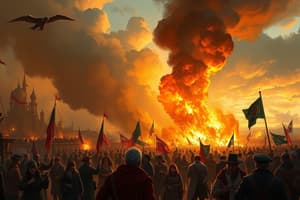Podcast
Questions and Answers
Hva er Social Justice Education Through the Arts?
Hva er Social Justice Education Through the Arts?
En tilnærming som vektlegger viktigheten av visuelle tekster i undervisning av både kunst og historie, med fokus på sosiale rettferdighetsproblemer.
Hva er hovedfokuset når man kombinerer kunst og historie i undervisning?
Hva er hovedfokuset når man kombinerer kunst og historie i undervisning?
Sosiale rettferdighetsproblemer.
Hva er målet med å studere de ulike kunstperiodene og bevegelsene?
Hva er målet med å studere de ulike kunstperiodene og bevegelsene?
Å få en dypere forståelse av kunstens rolle i dokumentasjon av historie og formingen av samfunnsdiskursen.
Hvordan kan kunst bidra til å dokumentere historie?
Hvordan kan kunst bidra til å dokumentere historie?
Hvordan kan kunst påvirke samfunnsdiskursen?
Hvordan kan kunst påvirke samfunnsdiskursen?
Hvorfor er det viktig å bruke visuelle tekster i undervisningen av kunst og historie?
Hvorfor er det viktig å bruke visuelle tekster i undervisningen av kunst og historie?
Hva kjennetegner renessanse-perioden innen kunst?
Hva kjennetegner renessanse-perioden innen kunst?
Hva var det særegne med barokken som kunstperiode?
Hva var det særegne med barokken som kunstperiode?
Hvilket fokus hadde impresjonismen som kunstbevegelse?
Hvilket fokus hadde impresjonismen som kunstbevegelse?
Hva var det sentrale i abstrakt ekspresjonisme som kunstperiode?
Hva var det sentrale i abstrakt ekspresjonisme som kunstperiode?
Hva kjennetegner postmodernismen som kunstbevegelse?
Hva kjennetegner postmodernismen som kunstbevegelse?
Hvordan kan bruk av visuelle tekster i undervisning bidra til dypere forståelse av komplekse sosiale temaer?
Hvordan kan bruk av visuelle tekster i undervisning bidra til dypere forståelse av komplekse sosiale temaer?
Study Notes
Introduction
The intersection of art and history offers a unique lens through which to view the past and its impact on contemporary society. In exploring this intersection, we delve into the ways in which art has been used to document history, express cultural values, and shape societal discourse. This article will examine the relationship between art and history, focusing on the social justice implications of using visual texts in teaching both subjects, as well as the major art periods and movements throughout history.
Art and History: A Connection
The use of art in teaching history has been recognized for its potential to enhance students' understanding of complex issues. This approach, known as Social Justice Education Through the Arts, emphasizes the importance of visual texts in teaching both art and history, with a focus on issues of social justice. By combining these two disciplines, educators can explore the relationship between art and history, offering a more holistic view of the past and its impact on the present.
Major Art Periods and Movements
The history of art is marked by a number of significant movements and periods, each with its own unique characteristics and cultural significance. By studying these periods, we can gain a deeper understanding of the role art has played in documenting history and shaping societal discourse. Some of the major art periods and movements include:
- Renaissance: This period, spanning the 14th to the 17th century, saw a revival of interest in classical Greek and Roman art, as well as a focus on humanism and individuality.
- Baroque: The Baroque period, which followed the Renaissance, was marked by its opulence and dramatic use of light and shadow.
- Impressionism: This movement, which emerged in the late 19th century, focused on the impression of light and color in the natural world.
- Abstract Expressionism: A post-war period that emphasized the artist's inner experiences and emotions, often expressed through non-representational forms.
- Postmodernism: This movement, which emerged in the late 20th century, rejected traditional art forms and embraced a more experimental, deconstructive approach.
Social Justice and Art Education
The intersection of social justice and art education has gained increasing attention in recent years. By using visual texts in teaching both art and history, educators can help students develop a deeper understanding of complex social issues and their historical contexts. This approach fosters critical thinking and empathy, allowing students to engage with the world in a more informed and compassionate manner.
Conclusion
The relationship between art and history is a complex one, offering a unique perspective on the past and its impact on contemporary society. By exploring the major art periods and movements throughout history, as well as the intersection of social justice and art education, we can gain a deeper understanding of the role art plays in documenting history and shaping societal discourse.
Studying That Suits You
Use AI to generate personalized quizzes and flashcards to suit your learning preferences.
Description
Explore the intricate relationship between art and history, focusing on how art has been used to document historical events, express cultural values, and shape societal discourse. Delve into major art periods like the Renaissance, Baroque, Impressionism, Abstract Expressionism, and Postmodernism, while examining the social justice implications of using visual texts in education.




